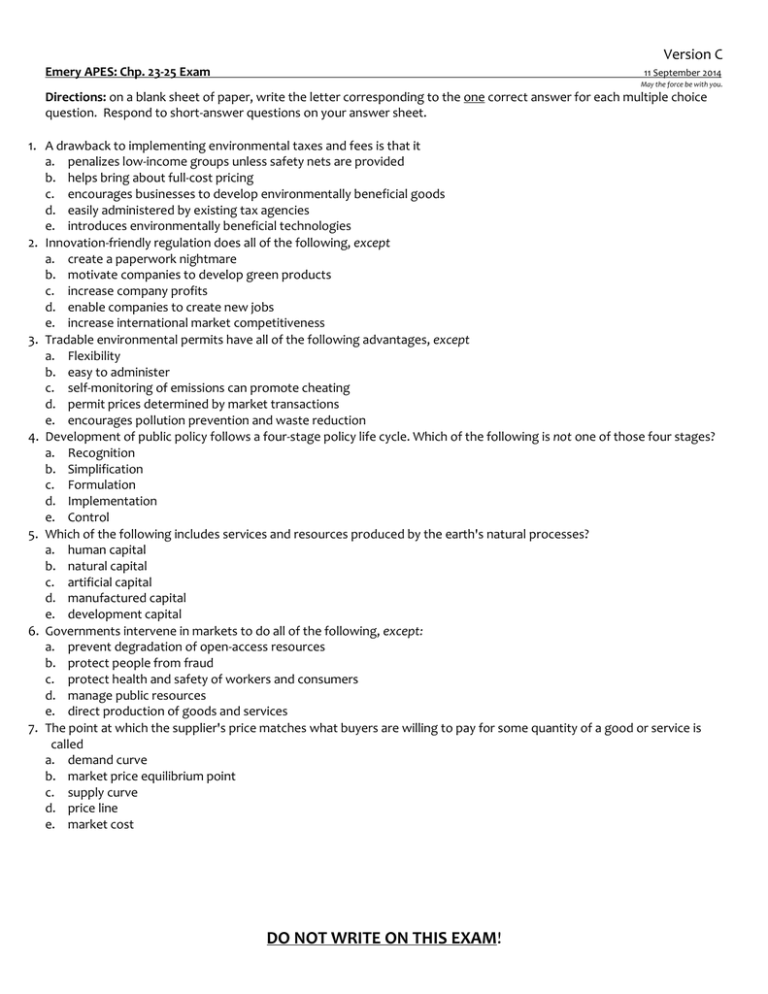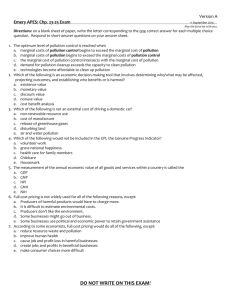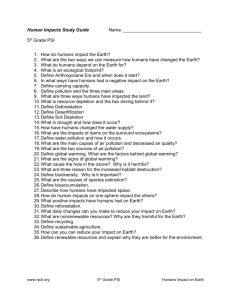do not write on this exam
advertisement

Version C Emery APES: Chp. 23-25 Exam 11 September 2014 May the force be with you. Directions: on a blank sheet of paper, write the letter corresponding to the one correct answer for each multiple choice question. Respond to short-answer questions on your answer sheet. 1. A drawback to implementing environmental taxes and fees is that it a. penalizes low-income groups unless safety nets are provided b. helps bring about full-cost pricing c. encourages businesses to develop environmentally beneficial goods d. easily administered by existing tax agencies e. introduces environmentally beneficial technologies 2. Innovation-friendly regulation does all of the following, except a. create a paperwork nightmare b. motivate companies to develop green products c. increase company profits d. enable companies to create new jobs e. increase international market competitiveness 3. Tradable environmental permits have all of the following advantages, except a. Flexibility b. easy to administer c. self-monitoring of emissions can promote cheating d. permit prices determined by market transactions e. encourages pollution prevention and waste reduction 4. Development of public policy follows a four-stage policy life cycle. Which of the following is not one of those four stages? a. Recognition b. Simplification c. Formulation d. Implementation e. Control 5. Which of the following includes services and resources produced by the earth's natural processes? a. human capital b. natural capital c. artificial capital d. manufactured capital e. development capital 6. Governments intervene in markets to do all of the following, except: a. prevent degradation of open-access resources b. protect people from fraud c. protect health and safety of workers and consumers d. manage public resources e. direct production of goods and services 7. The point at which the supplier's price matches what buyers are willing to pay for some quantity of a good or service is called a. demand curve b. market price equilibrium point c. supply curve d. price line e. market cost DO NOT WRITE ON THIS EXAM! Version C 8. All of the following are ideas of ecological economists, except a. There are no substitutes for many vital natural resources b. Human economic systems depend heavily on irreplaceable natural resources c. Continuing economic growth is necessary for providing businesses with profits d. We should discourage unsustainable forms of economic growth e. Market prices should include costs of harmful effects of producing goods 9. Which of the following is a strategy recommended by environmental economists to help make the transition away from unsustainable economic growth? a. Substitute ethanol or natural gas for oil b. Fine tune existing economic systems and tools c. Continue economic growth for the jobs d. Provide businesses with profits even though unsustainable e. Continue use of natural resources & develop technology to substitute depleted resources 10. Economic systems take natural capital and produce the following outputs, all of which are negative, except a. Depletion of nonrenewable resources b. Heat c. Pollution and waste d. Degradation of renewable resources e. Goods and services 11. Economists use ____ to estimate a resource's future economic value compared to its present value. a. internalized cost b. discount rate c. instrumental value d. trend analysis e. cost-benefit analysis 12. The optimum level of pollution control is reached when a. marginal costs of pollution control begins to exceed the marginal cost of pollution b. marginal costs of pollution begins to exceed the marginal costs of pollution control c. the marginal cost of pollution control intersects with the marginal cost of pollution d. demand for pollution cleanup exceeds the capacity to clean pollution e. technologies become affordable to clean up pollution 13. Which of the following is an economic decision-making tool that involves determining who/what may be affected, projecting outcomes, and establishing who benefits or is harmed? a. existence value b. monetary value c. discount value d. nonuse value e. cost benefit analysis 14. Which of the following is not an external cost of driving a domestic car? a. non-renewable resource use b. cost of manufacture c. release of greenhouse gases d. disturbing land e. air and water pollution 15. According to some economists, full-cost pricing would do all of the following, except a. reduce resource waste and pollution b. improve human health c. cause job and profit loss in harmful businesses d. create jobs and profits in beneficial businesses e. make consumer choices more difficult DO NOT WRITE ON THIS EXAM! Version C 16. In a constitutional democracy, which of the following is not a function of the constitution or its political institutions? a. provides for free elections b. guarantees free speech c. provides for a basis of governmental authority d. allows for gradual change e. establishes implementation of policies 17. Committing civilization to storing deadly radioactive wastes for up to 240,000 years is a failure of the a. humility principle b. reversibility principle c. precautionary principle d. prevention principle e. human rights principle 18. Motor vehicle drivers paying for the full cost of the harmful effects of fossil fuel use is the application of the a. precautionary principle b. public access principle c. human rights principle d. polluter-pays principle e. environmental justice principle 19. Future reliance on energy technologies such as ethanol from corn, shale oil, and nuclear power, would be a violation of which of the following? a. reversibility principle b. net energy principle c. precautionary principle d. prevention principle e. humility principle 20. Which of the following is not one of the principles that should govern use of public lands, according to free-market economists and conservationists? a. They should be used primarily to protect biodiversity. b. Government subsidies should not be used for extracting resources. c. Sale of the properties should be at fair market value. d. American people deserve fair compensation for use of the properties. e. Those that extract resources are responsible for environmental damage. 21. The body of statements defining what is acceptable environmental behavior for individuals and groups, according to the larger community, is a. common law b. administrative law c. statutory law d. environmental law e. civil law 22. All of the following would be forms of regulation, except a. requiring that certain resources be protected from unsustainable use b. setting acceptable levels of harmful activities c. banning the release of toxic chemicals into the environment d. selling pollution rights e. requiring that certain resources be based on sustainable use 23.Many things limit the effectiveness of an environmental lawsuit, including all of the following, except a. Plaintiffs must have legal standing. b. The government is always on the side of businesses. c. Lawsuits are very expensive. d. Public interest law firms can not recover fees unless Congress has agreed. e. Proving significant harm is time consuming and expensive. DO NOT WRITE ON THIS EXAM! Version C 24. Shifting to global and national societies that are more equitable and environmentally sustainable will require all of the following except: a. Sustainable forestry b. Increased water resource use c. Sustainable energy use d. Educating the public about the need e. Slowing projected climate change 25.Which of the following would not be part of the environmental wisdom worldview? a. Human ingenuity and technology will not allow us to run out of resources. b. We should encourage earth-sustaining forms of economic growth. c. Resources are limited and should not be wasted. d. Nature exists for all species and we are totally dependent on nature. e. Our success depends on learning how nature sustains itself. 26. Which of the following would not be included in the GPI, the Genuine Progress Indicator? a. volunteer work b. gross national happiness c. health care for family members d. Childcare e. Housework 27. The measurement of the annual economic value of all goods and services within a country is called the a. GDP b. GNP c. HPI d. GNH e. NIH 28. Full-cost pricing is not widely used for all of the following reasons, except a. Producers of harmful products would have to charge more. b. It is difficult to estimate environmental costs. c. Producers don't like the environment. d. Some businesses might go out of business. e. Some businesses use political and economic power to retain government assistance 29. Which of the following understands the earth to be a complex machine that we can understand, dominate, change, and manage for everyone's good without overloading natural systems? a. spaceship-earth b. planetary management c. deep ecology d. biocentric e. stewardship 30. Which of the following would not be one of the components of an environmental revolution? a. de-emphasis of population controls b. biodiversity protection c. transformation to sustainable energies d. emphasis on sufficiency e. commitment to eco-efficiency Short answer portion: 31. Examine the various worldviews as outlined in this section of the chapter. Which of these worldviews encompasses your understanding of how the world works? Is being aware of your worldview a helpful insight? Why or why not? 32.What are the environmental implications of the fact that the gap between the rich and the poor of this world is getting larger rather than smaller? 33. How has the Grameen Bank in Bangladesh impacted the environment? DO NOT WRITE ON THIS EXAM!






